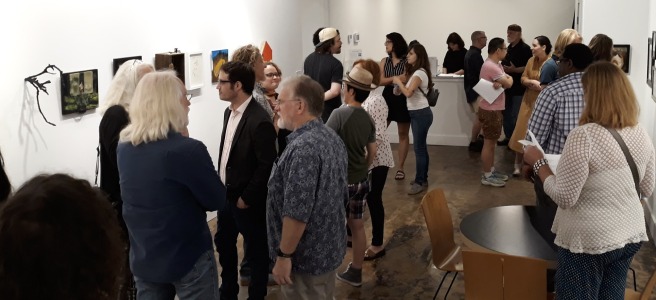Much of the past ten months have been spent in quarantine and that has changed just about everything. Social gatherings including concerts, museum exhibits, and gallery openings have been canceled. We’ve tried to make up for some of it with an online experience.
By now, we are used to watching the live stream of performances, attending virtual openings with artists providing Q&A, and “window shopping” at online art shows. These adaptations are not new but have become standard. As the pandemic lingers into 2021, we may be starting to forget the sensation of seeing art in person.
I do admit, not everything has been virtual for us. Outings have been far in between, but there have been a few. One reminder of the in-person experience came with a socially-distanced visit to the Valley House last summer. The main gallery showed Henry Finkelstein’s recent works, while the second room recreated what would have been shown at the Dallas Art Fair, had it not been canceled. At once, the familiarity of texture, brushstrokes, depth, and sophisticated hues came rushing back. It was a totally different experience from an exhibit online. There’s immense visual excitement that comes from facing a piece of art in person. “It’s not the same on a screen,” Cheryl Vogel offered her view and added, “if you have time, check out the lilies in the garden.” We obliged.
Given that we may still need to hunker down for the foreseeable future and venture further into the virtual, I began thinking about the downside of viewing art electronically.
The obvious drawback is a removed, watered-down experience even for the most straightforward works. The issue exacerbates for larger-scale works, three-dimensional works, conceptual art, or those with underlying tenets on processes and materials.
One of the last shows I saw before the pandemic was David Park’s retrospective at the Fort Worth Modern. Could I still respond emotionally without seeing how the lush oil paint was pushed around the canvas? I doubt it. At least for me, the physicality of the paint and the sensation are inseparable.
I also remember visiting the opening of Jen Pack’s work at Carneal Simmons Gallery. On a screen, the geometric shapes were interesting but characterless. In-person, the fabric and thread have their own life. Up close, the duel play between the tight folds, the stretched canvas, and the loosened ends feel organic and personal. On the way out, Eric offered an interesting comment – much better than I expected!
But there is a bigger issue with viewing art through the screen, especially from websites like Artsy or on Instagram. All are meant to attract user interactions. Their goal is to make one scroll and stay and to form an unconscious habit of coming back for more or less of what we have seen (and we know where this leads when it’s applied to politics). Essentially, we are in an endless loop trap inside our comfort zone.
I cannot remember where I read this so I am paraphrasing… The journey of art connoisseurship is to catch up with one’s inner self. We don’t know we have it in us until we let our eyes and mind open. When confronted with the unfamiliar, that initial response of being uncomfortable and being alienated by a new body of work often begins to dissipate given time to become familiar. That only happens if our curiosity can be piqued a little bit longer.
That’s a tall order online, but in a gallery, it’s not a major leap with crowds of familiar and unfamiliar faces encouraging the engagement. (Of course, a cup of wine helps.) Viewing through an app, a finger swipe can prove to be faster than our thoughts.
At Valley House, we had one particular painting in mind we wanted to see. Emily LaCour’s painting “Recentering” depicts a group of friends gathered around a table. The fluidity of paint and the splendid color palette are a delight in person. But more importantly, as Eric pointed out, nothing is more poignant and more relevant than the yearning for being with people. Zoom calls have their purpose, but smiles, hellos, and hugs triumph. The difference is no less when comparing pixels with paint.
Discover more from Urban Art & Antiques
Subscribe to get the latest posts sent to your email.


